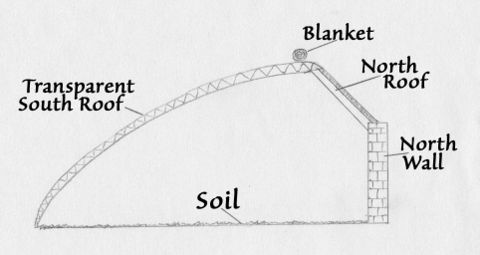Chinese Greenhouse: Difference between revisions
(stub) |
(+ image) |
||
| (16 intermediate revisions by the same user not shown) | |||
| Line 1: | Line 1: | ||
[ | [[File:Farmer-917998 960 720.jpg|480px|thumb|right|Farmers in Chinese greenhouse. Background shows implementation using concrete supports, a very economical and common design option.]] | ||
[[File:Chinese Greenhouse.jpg|480px|thumb|right|Chinese greenhouse, basic configuration. North wall as the main structural support. Transparent polyethylene foil coverage. Insulation blanket is rolled up and down. ]] | |||
http://www.lowtechmagazine.com/2015/12/reinventing-the-greenhouse.html | [[File:MushroomFarmChina.jpg|480px|thumb|right|Mushroom Farm in China, using a solar greenhouse, "curtains" down. ]] | ||
==Background== | |||
There is a special type of solar greenhouse that is common in China but largely unknown in the rest of the world. The concept originated in the 1970s and 80s and has been promoted by the government in China. To maximize solar heat collection, the greenhouse is facing south but has solid walls on its north (back), east and west side. Another feature is that it can be covered with insulating material at night (straw mats, other), which is then rolled up again in the morning. Most of these greenhouses do not require extra heating during the cold season, yet still manage to avoid freezing temperatures. The precise geometric configuration depends on latitude. All sorts of variations exist, from very low-tech, build-it-yourself versions with simple materials (bricks, rammed earth, bamboo, etc.) to very high-tech versions (steel, ventilation). The articles linked below, especially the one from Low-Tech Magazine, have much more information and photos. | |||
==Good for China== | |||
This type of greenhouse is perfect for China but it is unclear how well it will perform in other circumstances. | |||
* relatively low latitude and therefore high solar gain | |||
* cold winters but with little snow | |||
* strong, cold northern winds (to shield against) | |||
* cheap labor (to construct, to operate) | |||
* high population density (and therefore high local food demand) | |||
* strong government support for small-scale agriculture | |||
==Video== | |||
<html> | |||
<iframe width="560" height="415" src="https://www.youtube.com/embed/pnVZpXjPq2k" frameborder="0" allowfullscreen></iframe> | |||
</html> | |||
==Links== | |||
* Low-Tech Magazine: [http://www.lowtechmagazine.com/2015/12/reinventing-the-greenhouse.html "Reinventing the Greenhouse"] | |||
* Resilience.org: [http://www.resilience.org/stories/2010-04-06/solar-greenhouses-chinese-style "Solar greenhouses, Chinese-style"] | |||
* open access paper: [http://horttech.ashspublications.org/content/20/3/626.full "Structure, Function, Application, and Ecological Benefit of a Single-slope, Energy-efficient Solar Greenhouse in China"] (gives a nice overview: history, light, temperature, horticulture, etc.) | |||
* FAO: [http://www.fao.org/docrep/t4470e/t4470e0c.htm "Research on the temperature environment of solar greenhouse"] (has a lot of technical detail) | |||
[[Category:Food and Agriculture]] | |||
[[Category:Housing and construction]] | |||
Latest revision as of 17:01, 24 July 2016
Background
There is a special type of solar greenhouse that is common in China but largely unknown in the rest of the world. The concept originated in the 1970s and 80s and has been promoted by the government in China. To maximize solar heat collection, the greenhouse is facing south but has solid walls on its north (back), east and west side. Another feature is that it can be covered with insulating material at night (straw mats, other), which is then rolled up again in the morning. Most of these greenhouses do not require extra heating during the cold season, yet still manage to avoid freezing temperatures. The precise geometric configuration depends on latitude. All sorts of variations exist, from very low-tech, build-it-yourself versions with simple materials (bricks, rammed earth, bamboo, etc.) to very high-tech versions (steel, ventilation). The articles linked below, especially the one from Low-Tech Magazine, have much more information and photos.
Good for China
This type of greenhouse is perfect for China but it is unclear how well it will perform in other circumstances.
- relatively low latitude and therefore high solar gain
- cold winters but with little snow
- strong, cold northern winds (to shield against)
- cheap labor (to construct, to operate)
- high population density (and therefore high local food demand)
- strong government support for small-scale agriculture
Video
Links
- Low-Tech Magazine: "Reinventing the Greenhouse"
- Resilience.org: "Solar greenhouses, Chinese-style"
- open access paper: "Structure, Function, Application, and Ecological Benefit of a Single-slope, Energy-efficient Solar Greenhouse in China" (gives a nice overview: history, light, temperature, horticulture, etc.)
- FAO: "Research on the temperature environment of solar greenhouse" (has a lot of technical detail)


